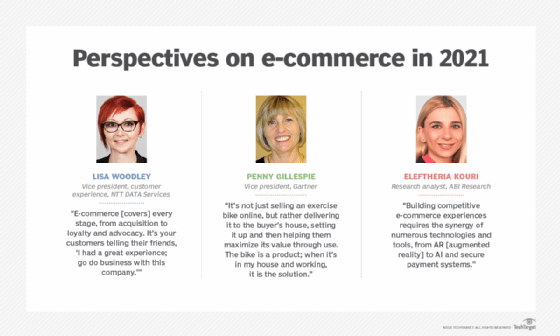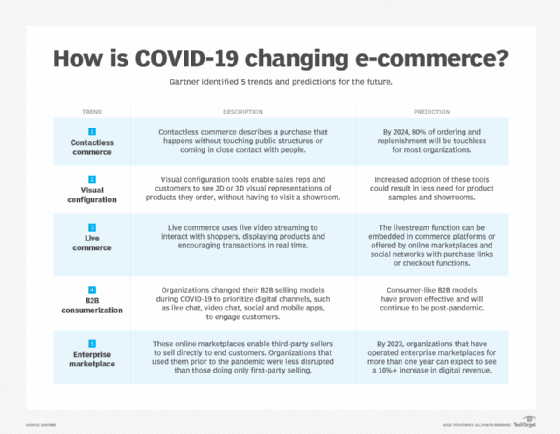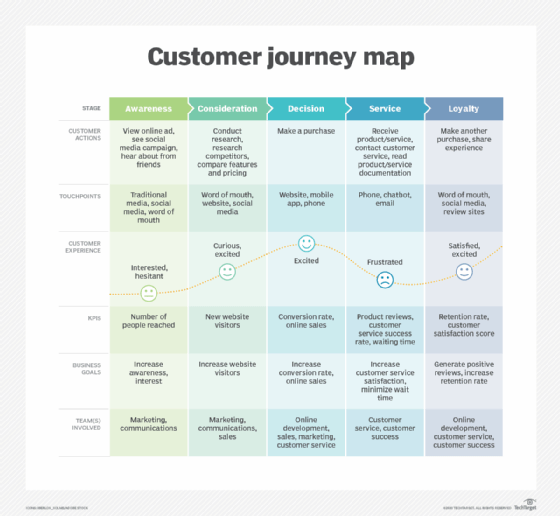The future of e-commerce: Trends, tips, traps to avoid
The term 'e-commerce' has been around for decades. What does it mean for today's businesses? Not what it did in the 1990s -- or even a mere 12 months ago.
Amazon is approaching its 30th anniversary, set to mark the milestone in 2024. The World Wide Web hits 35 the same year. E-commerce, the buying and selling of goods and services over the internet, has grown up -- and it has gotten big. Worldwide e-commerce sales for the retail sector alone exceeded $4 trillion in 2020, according to eMarketer. The research firm expects the figure to hit $5 trillion in 2022. Global B2B e-commerce sales, meanwhile, hovered around $6.6 trillion in 2020, according to research firm Frost & Sullivan.
As the value of e-commerce has risen, so has the complexity of online transactions. E-commerce today means more than simply processing electronic payments and enabling internet sales. It's also more than knowing your customer, crucial as that is. E-commerce sales in 2021 depend upon the robust performance of just about every aspect of modern enterprises, from operations and supply chain to delivery services and customer loyalty programs.
Organizations must harness all the power of integrated back-office systems in tandem with intelligent customer insight systems to deliver personalized, seamless digital transactions that -- in the lingo of the age -- delight the customer. Personalized, seamless transactions must happen whether the customer is an individual consumer buying his or her first product, or a global business ordering for the 100th time under a multiyear procurement contract. Buyers demand as much -- whether they're ordering from their computer or their smartphone, via Alexa or through another connected machine.
"E-commerce transactions are becoming ubiquitous, and expectations are going up. People have expectations that it's always going to be as easy as using Uber to get a ride," said Mike Welsh, chief creative officer at Mobiquity, a digital consulting agency.
 Mike Welsh
Mike Welsh
Amid rising customer expectations, however, many organizations are falling short on their e-commerce operations. A Gartner report on the COVID-19 pandemic's impact on digital commerce predicted that "through 2020, 50% of large organizations will have failed to unify engagement channels, resulting in a disjointed and siloed customer experience that lacks context."
The bar is high, said Lisa Woodley, vice president of customer experience at NTT Data Services. "E-commerce [covers] every stage, from acquisition to loyalty and advocacy. It's your customers telling their friends, 'I had a great experience; go do business with this company.'"
In this look at the future of e-commerce, we examine the evolution of buying and selling over the internet -- from the early corporate websites that functioned as online brochures to today's powerful, concierge selling sites that can be accessed through multiple channels. We offer expert analysis of the impact of COVID-19 on digital transactions, delve into the challenges enterprises face in meeting customer expectations in 2021, and provide detailed advice on overcoming those challenges.

From 'product-centric' to 'solution-centric,' e-commerce evolves
A combination of factors is driving the evolution of e-commerce. At the core is the internet.
Companies once mostly competed on the so-called four P's of marketing: place, price, product and promotion. But the web's search function and the internet's reach neutralize one or more of these differentiating factors. Shopping online, a customer can easily get the same or similar product at the same or lower price with comparable shipping times and costs.
As a result, other factors are emerging as key differentiators, with personalization being the catch-all term for the new elements that drive buying habits in the digital realm.
"The concept of e-commerce is shifting from online sale transactions [and a] static webpage to a personalized and interactive experience," said Eleftheria Kouri, a research analyst with the tech market advisory firm ABI Research.
"Customers have access to a wider range of capabilities when visiting an online store, including product virtual try-on and gaming and interactive storytelling concepts that increase engagement and educate the consumer about products [and] brands."
Penny Gillespie, vice president at Gartner and a fellow in its customer experience/digital commerce team, said that in the e-commerce marketplace of 2021, companies must figure out how to deliver the product and the solution to a customer's problem. To do that, they must understand the online customer's intent.
For example, a retailer serving a customer searching for a black dress should be capable of using digital tools, as well as general and personal data, to understand that the shopper doesn't simply need a dress but rather needs an outfit for an event. In fact, the color of the dress may in this case be irrelevant -- with black dress being nearly synonymous with cocktail dress.
"Understanding intent is part of personalizing an experience," Gillespie explained. A retailer that understands this concept can ensure the products in the search results actually match that customer's needs, guaranteeing the sale of a dress and other relevant items (e.g., accessories) -- and ensuring repeat business.
Customer intent is relevant in B2B transactions as well. Here, it could mean understanding a customer's unique procurement process by, for example, automatically displaying any special prices specified by an existing procurement contract, facilitating any approval requirements, and anticipating needs based on past ordering histories.
"It's a work in progress, with some sellers being much better at it than others," Gillespie said.
In both the B2C and B2B spaces, online selling has gone from being reactive to being proactive and participatory, said Gillespie: "It's a move from being product-centric to solution-centric." She used the sale of an exercise bike online as an example.
"It's not just selling an exercise bike online, but rather delivering it to the buyer's house, setting it up and then helping them maximize its value through use," she said. "The bike is a product; when it's in my house and working, it is the solution."
COVID-19 pushes companies and customers into the digital realm
The evolution of e-commerce from static webpages to interactive customer "solution" sites was enabled by sophisticated technology, but it took a global health crisis to make the future of e-commerce the new normal. The shift to online-everything in 2020 due to pandemic-induced social restrictions and quarantine orders pushed physical transactions into the digital realm.
According to findings from consulting firm McKinsey & Company, e-commerce as a percentage of overall retail sales in the U.S. grew 3.3 times more in 2020 than the average annual rate in five years before COVID-19. E-commerce sales as a share of overall retail sales grew 4.6% in 2020 vs. an average of 1.4% growth in previous years.
 Nicole West
Nicole West
"Consumers are demanding more digital access than ever before," said Nicole West, vice president of digital strategy and product at Chipotle Mexican Grill.
In November, the restaurant chain opened its first "digital-only restaurant," the Chipotle Digital Kitchen, in Highland Falls, N.Y. The location offers pickup and delivery only, a prototype the company said will allow Chipotle to enter more urban areas that don't support its full-size restaurant concept. The new restaurant requires customers to order in advance via Chipotle.com, its app or through third-party delivery partner platforms.
Providing an exceptional digital experience has become a priority for the 28-year-old chain, West said. She added that Chipotle is "relentless when it comes to UX and making it fast, easy and convenient" to place digital orders.
She cited the company's 2020 rollout of Unlimited Customization. A feature in the Chipotle app and on the company's website, it allows customers to customize orders, just as they do when ordering in person at a restaurant. Earlier in 2020, the company launched ordering on Facebook Messenger and a Group Ordering feature, which allows multiple people to participate in the ordering process simultaneously on the Chipotle app and Chipotle.com. And it's now testing Chipotle Carside at 29 restaurants in California, an in-app feature that lets customers have their Chipotle orders delivered to their parked cars.
Chipotle's digitalization efforts have shown real-world business value. Digital sales for Chipotle have grown 177% year over year, West said, and they accounted for 49% of sales in the last quarter of 2020. More than 19 million people joined the company's customer rewards program via digital sales, West added, noting that the company's digital pickup orders are currently its most lucrative transaction type.

E-commerce trends
The appetite for digital access is unlikely to abate. The McKinsey report cited above noted that approximately three-quarters of people who used digital channels for the first time during the pandemic said they plan to continue using them when normalcy returns.
There is no denying that the COVID-19 crisis and the at-home new norm have reshaped consumer behavior and boosted e-commerce/online shopping, which is expected to continue growing after the end of the pandemic, ABI Research's Kouri said.
The technology powering these e-commerce trends also continues to evolve rapidly, Kouri noted, citing technological advancements in smartphones -- such as high-resolution cameras and displays -- enhanced connectivity, mobile-friendly websites and the rise of social media shopping.
Amazon, of course, has continued to make online shopping easier with innovations such as its Add to Cart and Buy Now buttons. The Home Depot and Lowe's are often lauded for their use of instructional videos that give customers confidence to make purchases, as well as for apps that help customers navigate their stores. And the use of various technologies to let customers see how their items will look on them or in their homes before they buy is becoming standard practice.
From the customer's perspective, Gartner's Gillespie noted, the benchmark for all digital transactions is "the last great experience they had." Keeping up with that moving target will require a panoply of technology and continuous technology innovation.
Kouri and other commerce experts don't expect physical stores to cease existing. But digital trends will reshape them, forcing retailers to compete with online experiences by matching price and personalization while also complementing the digital experiences with the types of experiences -- like on-the-spot customized tailoring -- that can only be offered in the physical world.
E-commerce technologies
Although the internet was the enabling technology for e-commerce, it is far from the only technology needed to deliver the experience that customers expect now and moving forward. Some of these broad technology capabilities include the following:
- Customer-facing capabilities. Sites must be easy to navigate and user-friendly as well as quick and responsive. Sites should have the features that matter most to the target audience and be able to interact with other sites -- social media sites for young consumers, for example, or company procurement systems for corporate customers.
- Data-related technologies. Organizations must be capable of collecting and using their own data as well as data from outside sources. This allows the organization to anticipate a customer's needs even when it has little or no data on that specific customer; the company can use its other data sources to compile an understanding of what that one customer needs based on its interactions with similar customers.
- Automation technologies such as RPA. Robotic process automation can speed and streamline processes that service the customer by minimizing errors in data collection, enabling self-service by providing access to back-end systems.
- Customer journey orchestration engine software. This class of tools help organizations analyze real-time data of individual customers to predict future interactions with that customer, using predictive models, decision trees, matrix rules and machine learning.
- Augmented reality. AR lets customers bring products into real lifelike situations and virtually try on or fit items before purchasing. "The introduction of digital tools, such as augmented reality, in e-commerce platforms or apps not only assists brands to differentiate from the competition but transfers static websites/2D images to interactive and personalized experiences," Kouri said.
- Artificial intelligence. Organizations can use AI to offer personalized online experiences. A cosmetics brand, for instance, could use AI algorithms to provide skin analysis and recommend suitable products.
- Back-end systems. Companies need modern infrastructure and current IT architecture that can support all these other capabilities. Typically, this means moving from legacy systems to cloud computing and SaaS applications to quickly enable scale and speed when needed; leveraging microservices to increase agility and flexibility; and breaking down silos through integration and the use of APIs. "There's actually a lot more on the back end needed to reach our goal of making the front-end experience as seamless as possible," Woodley said.
Specific tools, such as geofencing platforms that provide location-based services to help organizations and customers pinpoint their locations, and payment systems also have an important role in an e-commerce strategy, as do the technologies and processes companies use to optimize their warehouse and supply chain management.
"Building competitive e-commerce experiences requires the synergy of numerous technologies and tools, from AR to AI and secure payment systems," summed up Kouri.
E-commerce challenges
Bringing all these parts together to work consistently and flawlessly is, not surprisingly, a significant challenge.
"Personalization is not a one-size-fits-all approach. You really need to consider your business model, value proposition and customers before you create your strategy. Once those pieces are solidified, you can then begin to seek out the right tools and technologies needed to be successful," said Britt Mills, senior director of customer experience at Mobiquity.
 Britt Mills
Britt Mills
Organizations also need the data experts, technologists, marketing team, logistics workers, supply chain personnel and other executives and supporting staff who can competently contribute to that vision.
"Stores can rush to market with a new technology to enable customer safety and convenience, but they shouldn't do so at the customer's expense," Mills said. Training employees to use the new technology is essential. "If your associates can't support this new expected experience, your customers won't be satisfied. It doesn't matter how great the technology is."
In addition, companies must have a strategy for dealing with emerging data use laws that put more control over personal information into the hands of individuals. And they must be able to mitigate against escalating cybersecurity risks.
These capabilities and safeguards are hard to achieve. Experts have acknowledged that the difficulty of developing and implementing know-your-customer processes -- from collecting the necessary data to analyzing it to turning it into action items -- has been oversimplified and glossed over in many conversations.
It's not shocking, then, to learn that most organizations are struggling to develop the capabilities required to deliver seamless, personalized service, especially as the number of engagement and delivery channels have increased.
Research from Verint, a provider of customer engagement management products, found that 82% of the nearly 2,300 business leaders it surveyed said the challenges of managing customer engagement will increase in 2021, but only 50% said they're well prepared to support customer engagement priorities moving forward. The vast majority of those surveyed pointed to nearly every aspect of customer engagement as challenging for their organizations, indicating the following problems:
- understanding and acting on rapidly changing customer behaviors (94% cited);
- managing the growth in volume of customer interactions (88%);
- achieving a unified view of customer engagement and overcoming data silos (79%);
- using customer feedback to improve experiences (78%); and
- building enduring customer relationships (77%).
Customer journey mapping
How do traditional organizations become as competitive in the digital sphere as they were in the brick-and-mortar heyday? It starts with mastering customer journey mapping, according to Peter Charness, vice president of retail strategy for UST, a digital technology and transformation IT services and solutions firm.
"[Organizations] need to ensure the digital journey is well aligned to a shopper's needs, using a high degree of personalization and creating relevant interactions and conversations," Charness said. He laid out six areas where organizations need to benchmark their capability:
 Peter Charness
Peter Charness
- Interest generation. Determine how successful your organization is at getting potential customers to its website or store.
- Research and decision influence. Examine whether it's easy for the user to find products of interest and "gather the information and confidence they need to move that product into a shopping cart," Charness said.
- Decision confidence. From browsing to buying, companies should make it easy for the shopper to say yes to a purchase. "Organizations should have this part of the conversation with their shoppers and build their confidence to press 'buy,'"Charness noted.
- Delivery/collection. "Speed of delivery (with ease of return implied) comes next, and the cost to deliver or collect a product becomes one of the most relevant associations any retailer will have to profitability and customer satisfaction," Charness said. Assess your supply chain and fulfillment capabilities, and benchmark them to competitors and best-in-class companies.
- Post-sales service, resales and loyalty. "Your conversation with your customer doesn't end with the shipment," Charness Consider what else you can say to or advise your customer on to keep the relationship alive and productive.
- Personalization everywhere. "Put yourself in your shopper's shoes, and play back the conversations you've had during the entire shopper journey," Charness said. "Was it always relevant, interesting and useful? Or did you communicate with mass marketing techniques, treating everyone the same?" Develop a strategy for using AI and machine learning across "the end-to-end interaction chain" with customers to enhance personalized service.

The future of e-commerce
Many businesses have been on their e-commerce journey for years, adapting business processes to the customer predilection for digital transactions. However, few were well prepared for the rapid and wholesale shift to digital transactions driven by the pandemic. A record-breaking 11,100-plus stores closed in the U.S. last year, and 40 major retailers filed for Chapter 11 bankruptcy protection, according to CoStar Group, a collector of retail real estate data. More stores are expected to shutter in the upcoming years, with some analysts predicting 100,000 stores -- mostly apparel retailers -- could close by 2025.
Yet, despite their struggles and challenges, many organizations are on their way to success. The awareness that challenges must be faced and addressed indicates that organizations understand that data-driven, personalized and secure customer transactions are the future.
How these transactions happen -- whether online, via a mobile device, through some combination of digital and physical channels or by some augmented reality lens not yet imagined -- will depend on circumstances and customer preferences, but they will increasingly involve digital technologies.
Indeed, Gartner has advocated replacing the term e-commerce with digital commerce to better reflect the convergence of all the digital systems that go into transactions today.
As customers increasingly decide that the frictionless experiences they have when buying online from leading digital vendors are the norm, the semantic distinction between e-commerce or digital commerce or any other kind of buying and selling transaction will disappear.
"When it's all said and done," Gillespie said, "we'll just call it commerce."
Pointers on improving mobile commerce
Mobile transactions are expected to make up 72.9% of all retail e-commerce sales worldwide in 2021, up from about half in 2016, according to the German market and consumer data firm Statista. Revenue from mobile retail commerce is also up significantly, with Statista reporting that it went from $207.15 billion in 2018 in the U.S. to some $340 billion in 2020.
Britt Mills, senior director of customer experience at the digital consulting agency Mobiquity, offers advice on how companies can improve the mobile experience they offer customers.
How do enterprises develop a mobile strategy to ensure seamless engagement in the B2C and B2B environments?
Britt Mills: There are a few key steps that every brand should consider when creating a mobile e-commerce experience:
- Consider your current business model: How do you currently conduct business today, and how does that need to change? What priorities are most important for launch to satisfy customers and what can be released in later phases?
- Understand what technology you'll need that you don't already have, or what kinds of upgrades you need to make to your current technology: There are a number of vendors [with capabilities to] ensure there is an integration between the customer's app and a business's back-end POS [point-of-sale] system. You need to be really clear on this part before starting the work to bring your solution to life.
- Create a change management strategy: One of the biggest mistakes we see is companies that don't prepare their teams for the change. This can be so easily avoided with a little extra time spent training the staff on how the mobile app upgrades work and how to help customers troubleshoot issues.
- Measure and refine: Have a plan for regularly checking in on how the mobile app is being used.
What can companies do to ensure their mobile app provides a pleasurable shopping experience?
Mills: User interfaces are all about simplicity. While you may think you need a ton of widgets on every screen, you really only need a few elements to satisfy your customers. Most importantly, you want to ensure that every screen offers a journey for customers so that adding items to their cart, placing the order and checking out is frictionless.
For example, consider adding a "last ordered" section where customers can view their prior orders and simply reorder their favorites. Another way to minimize customer effort is to make redeeming rewards via the app simple with just one click upon checkout. These kinds of automations can make the experience so much better. According to one report, and in light of the pandemic, 66% of consumers will switch after just one or two bad experiences; and with this kind of data, it's imperative for companies to make their interfaces easy to navigate for a more pleasurable engagement. --Mary K. Pratt







